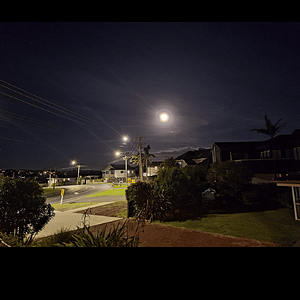Navigation
Install the app
How to install the app on iOS
Follow along with the video below to see how to install our site as a web app on your home screen.

Note: This feature currently requires accessing the site using the built-in Safari browser.
More options
You are using an out of date browser. It may not display this or other websites correctly.
You should upgrade or use an alternative browser.
You should upgrade or use an alternative browser.
Diffractive Optics
- Thread starter Buszaj
- Start date
Garbz
No longer a newbie, moving up!
- Joined
- Oct 26, 2003
- Messages
- 9,713
- Reaction score
- 203
- Location
- Brisbane, Australia
- Website
- www.auer.garbz.com
- Can others edit my Photos
- Photos NOT OK to edit
It's a lens with an optical diffraction grating in the middle. The purpose is that it corrects the fact that light bends at different angles depending on their wavelength.
This is called chromatic aberration (red / cyan) fringing on the edge of sharp contrasts when shooting wide open. And the Diffractive optics uses the principle of diffraction to correct it.
Have a look at Canon's marketing material by doing a google search and it'll show you an example drawing of what this lens looks like. It should be pretty clear that this is an insanely hard design to cut and polish.
This is called chromatic aberration (red / cyan) fringing on the edge of sharp contrasts when shooting wide open. And the Diffractive optics uses the principle of diffraction to correct it.
Have a look at Canon's marketing material by doing a google search and it'll show you an example drawing of what this lens looks like. It should be pretty clear that this is an insanely hard design to cut and polish.
Alpha
Troll Extraordinaire
- Joined
- Mar 15, 2005
- Messages
- 5,451
- Reaction score
- 41
- Location
- San Francisco
- Can others edit my Photos
- Photos NOT OK to edit
No offense Garbz, but screw Canon. Really. Screw Canon. They were one of the last manufacturers to develop an APO lens. Why give them so much credit for the technical aspects of building one?
JerryPH
No longer a newbie, moving up!
- Joined
- Oct 14, 2007
- Messages
- 6,111
- Reaction score
- 15
- Location
- Montreal, QC, Canada
- Can others edit my Photos
- Photos NOT OK to edit
Holy crap dude, no one gave cedit anywhere. You asked a question, Garbz gave an aswer. If you do not like the answer, at least have the courtesy to thank the person helping you and keep your severely negative opinions to yourself.
Alpha
Troll Extraordinaire
- Joined
- Mar 15, 2005
- Messages
- 5,451
- Reaction score
- 41
- Location
- San Francisco
- Can others edit my Photos
- Photos NOT OK to edit
Holy crap dude, no one gave cedit anywhere. You asked a question, Garbz gave an aswer. If you do not like the answer, at least have the courtesy to thank the person helping you and keep your severely negative opinions to yourself.
Jerry, clean your glasses. I didn't ask the question. Someone else did.
Buszaj
TPF Noob!
- Joined
- May 23, 2007
- Messages
- 521
- Reaction score
- 0
- Location
- Toronto
- Can others edit my Photos
- Photos OK to edit
No offense Garbz, but screw Canon. Really. Screw Canon. They were one of the last manufacturers to develop an APO lens. Why give them so much credit for the technical aspects of building one?
Whoa, take it easy. Garbz did not say that Canon invented the idea, but that they have detailed drawings of all their lenses.
Alpha
Troll Extraordinaire
- Joined
- Mar 15, 2005
- Messages
- 5,451
- Reaction score
- 41
- Location
- San Francisco
- Can others edit my Photos
- Photos NOT OK to edit
Just stressing the fact that this is hardly a proprietary design.
Garbz
No longer a newbie, moving up!
- Joined
- Oct 26, 2003
- Messages
- 9,713
- Reaction score
- 203
- Location
- Brisbane, Australia
- Website
- www.auer.garbz.com
- Can others edit my Photos
- Photos NOT OK to edit
Jesus go get a massage and cup of tea or something and calm down. He asked about diffraction optics, not APO. Since he asked for the canon marketing term I told him to go to the canon marketing website where they can blow their own horn, just like if he'd has asked for VR I'd have sent him to Nikon's website, or IS I'd send him to Canon, or HSM I'd send him to Sigma.
I assumed he's a canon user since he asked for "Diffractive Optics"
I never said they invented it. Hell I'm a Nikon shooter, Canon users have big enough heads as it is
I assumed he's a canon user since he asked for "Diffractive Optics"
I never said they invented it. Hell I'm a Nikon shooter, Canon users have big enough heads as it is
JerryPH
No longer a newbie, moving up!
- Joined
- Oct 14, 2007
- Messages
- 6,111
- Reaction score
- 15
- Location
- Montreal, QC, Canada
- Can others edit my Photos
- Photos NOT OK to edit
Jerry, clean your glasses. I didn't ask the question. Someone else did.
Go take a valium. You were the one off the hook... and I do not wear glasses.
Jon, The Elder
TPF Noob!
- Joined
- Jul 10, 2007
- Messages
- 376
- Reaction score
- 0
- Location
- Southeastern Michigan
- Website
- www.pbase.com
- Can others edit my Photos
- Photos NOT OK to edit
Well....that was certainly a pleasant little interlude.
usayit
No longer a newbie, moving up!
- Joined
- Nov 15, 2003
- Messages
- 9,521
- Reaction score
- 347
- Can others edit my Photos
- Photos OK to edit
Yes it was...
Alpha should be especially embarrassed....
First... he read misinformation into Garbz post
Second... APO = apochromatic optics
READ>> http://en.wikipedia.org/wiki/Apochromat
Third... DO = Diffractive Optics
READ>> http://www.usa.canon.com/consumer/controller?act=CanonAdvantageTopicDtlAct&id=2632
Two completely different technologies in optics...... APOs don't have diffractive grating in their glass elements.....
My limited understanding leads me to believe that APOs and DOs both control chromatic aberration but do so in different ways. The "Canon Advantage" to using DO optics is that it can achieve good control over CA with less glass... which results in a compact and lighter package. The compact and lighter package is the big selling point..... although I myself don't really care for DO too much. I believe Canon (and many lens manufacturers) were employing APO type elements well before DO was even on the drawing board.
btw.. Do other manufacturers of lenses have an equivalent technology to Canon's DO?
Alpha should be especially embarrassed....
First... he read misinformation into Garbz post
Second... APO = apochromatic optics
READ>> http://en.wikipedia.org/wiki/Apochromat
Third... DO = Diffractive Optics
READ>> http://www.usa.canon.com/consumer/controller?act=CanonAdvantageTopicDtlAct&id=2632
Two completely different technologies in optics...... APOs don't have diffractive grating in their glass elements.....
My limited understanding leads me to believe that APOs and DOs both control chromatic aberration but do so in different ways. The "Canon Advantage" to using DO optics is that it can achieve good control over CA with less glass... which results in a compact and lighter package. The compact and lighter package is the big selling point..... although I myself don't really care for DO too much. I believe Canon (and many lens manufacturers) were employing APO type elements well before DO was even on the drawing board.
btw.. Do other manufacturers of lenses have an equivalent technology to Canon's DO?
Garbz
No longer a newbie, moving up!
- Joined
- Oct 26, 2003
- Messages
- 9,713
- Reaction score
- 203
- Location
- Brisbane, Australia
- Website
- www.auer.garbz.com
- Can others edit my Photos
- Photos NOT OK to edit
Actually apochromatic optics is just the generic term used for correcting CA.
Sigma uses the "APO" technology and show the marketing department has no creativity what so ever, Nikon use ED coatings, and I believe Nanocrystal coatings also have an APO effect, Canon has DO and another I believe, but the principles are similar, bring light beams projected in different places through the colour spectrum to the same point.
The jury is out on whether this is best achieved by using a diffraction grating, or by using a coating that varies the refractive index, or what not. They each have their plusses and minuses. The obvious minus on the DO is the cost of producing the element is high.
Sigma uses the "APO" technology and show the marketing department has no creativity what so ever, Nikon use ED coatings, and I believe Nanocrystal coatings also have an APO effect, Canon has DO and another I believe, but the principles are similar, bring light beams projected in different places through the colour spectrum to the same point.
The jury is out on whether this is best achieved by using a diffraction grating, or by using a coating that varies the refractive index, or what not. They each have their plusses and minuses. The obvious minus on the DO is the cost of producing the element is high.
A
astrostu
Guest
As a small answer to the original poster - why it's so expensive - is because it's fairly new in the world of lenses. Anything new usually is more expensive due to the R&D to get it out there and the new machinery to manufacture it.
Personally, I think it's too new to start investing in. In other words, I think that diffractive optics -based lenses are still evolving and will be better, lighter weight, and cheaper in, say, a decade.
Personally, I think it's too new to start investing in. In other words, I think that diffractive optics -based lenses are still evolving and will be better, lighter weight, and cheaper in, say, a decade.
yeti
TPF Noob!
- Joined
- Jan 8, 2008
- Messages
- 115
- Reaction score
- 0
- Can others edit my Photos
- Photos OK to edit
DO = Diffractive Optics, as so many before you have already mentioned.
What this really means is that there is a diffraction grating embedded within the glass: a series of slits creating a grid with width in the order of the wavelength of light. Light hates being constrained in this fashion, so it bends and spreads, trying to fill the space behind the grating. This effect is different for the different wavelengths of light, but as it turns out, that counters most of the optical artifacts from a purely refractive optics, meaning that things like chromatic aberrations and various distortions are next to nonexistant. It also allows a lens containing a diffraction grating to bend light a lot more, eliminating the need for more elements.
Image-quality-wise, however, things are not all good: there is slight softness in parts of their image. I am not sure what causes it, but my guess is waves of like wavelengths following paths through different slits interfering with each other, producing interference minima. Maybe if Canon creates an EF-S DO lens, things aren't going to be nearly as bad, and stooping down the lens will probably also help (I haven't handle one, so I don't know) but as far as I can see the idea is largely abandoned now. Most people on this forum tend to believe that it compromises image quality too much.
It's still a nice idea, though. I hate seeing it go nowhere.
What this really means is that there is a diffraction grating embedded within the glass: a series of slits creating a grid with width in the order of the wavelength of light. Light hates being constrained in this fashion, so it bends and spreads, trying to fill the space behind the grating. This effect is different for the different wavelengths of light, but as it turns out, that counters most of the optical artifacts from a purely refractive optics, meaning that things like chromatic aberrations and various distortions are next to nonexistant. It also allows a lens containing a diffraction grating to bend light a lot more, eliminating the need for more elements.
Image-quality-wise, however, things are not all good: there is slight softness in parts of their image. I am not sure what causes it, but my guess is waves of like wavelengths following paths through different slits interfering with each other, producing interference minima. Maybe if Canon creates an EF-S DO lens, things aren't going to be nearly as bad, and stooping down the lens will probably also help (I haven't handle one, so I don't know) but as far as I can see the idea is largely abandoned now. Most people on this forum tend to believe that it compromises image quality too much.
It's still a nice idea, though. I hate seeing it go nowhere.
Most reactions
-
 432
432 -
 289
289 -
 285
285 -
 272
272 -
 221
221 -
 203
203 -
 185
185 -
 178
178 -
 167
167 -
 166
166 -
 148
148 -
 134
134 -
 120
120 -
 95
95 -
I
94
Similar threads
- Replies
- 4
- Views
- 427
- Replies
- 20
- Views
- 501
- Replies
- 10
- Views
- 959

![[No title]](/data/xfmg/thumbnail/37/37604-7ad625e983f92f880eb65a264eeef5e4.jpg?1619738148)





![[No title]](/data/xfmg/thumbnail/31/31747-2e2e2bda16938a6a1d5fd6120c558293.jpg?1619734987)
![[No title]](/data/xfmg/thumbnail/31/31744-f06a1a9bb9c74e3b8b332878f5fe71f1.jpg?1619734986)



